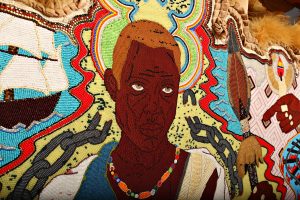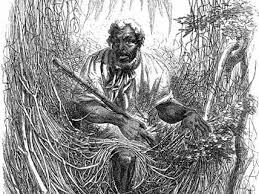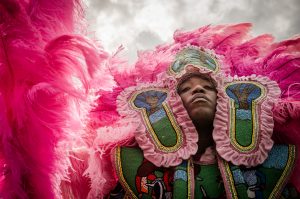The celebration of the Mardi Gras tradition has an interesting beginning as it originated from the French settlers of New Orleans. African Americans were banned from partaking in the French settlers’ Mardi Gras Krewes to which they responded by making their own celebration for Fat Tuesday called “The Carnival”. From the start of the celebration of the Carnival also came the mysterious subtradition of the Mardi Gras Indians who first appeared in 1895. Nobody quite knows where the tradition originated from or what the original intentions were. Today; the tradition is seen as a way to commemorate and thank the Natives of New Orleans for helping African Americans escape enslavement. However, the story of the Mardi Gras Indians started long before the first Carnival with a friendship between the Lousianna Native Americans and the African American slaves.
 The forty Mardi Gras Indian Tribes with names such as the Congo Nation, Guardians of the Flame, Yellow Pocahontas and Wild Magnolias are a hard sight to miss when attending New Orleans celebrations like Mardi Gras, Super Sunday, and Saint Joseph Day. Their costumes, often weighing up to 150 pounds, are covered in feathers, rhinestones, beads, and velvet that dedicated artists have put a year’s worth of work into. Putting together one Mardi Gras Indian Costume is reported to cost around $5,000 in materials such as fabrics and countless beads. The intricate beading made by master beaders depicts stories of resilience. Costumes picture inspiring stories such as the Natives helping escaping slaves, Native traditions, spirit animals, and people who fought for equality amongst races such as Mr. Luther King Junior.
The forty Mardi Gras Indian Tribes with names such as the Congo Nation, Guardians of the Flame, Yellow Pocahontas and Wild Magnolias are a hard sight to miss when attending New Orleans celebrations like Mardi Gras, Super Sunday, and Saint Joseph Day. Their costumes, often weighing up to 150 pounds, are covered in feathers, rhinestones, beads, and velvet that dedicated artists have put a year’s worth of work into. Putting together one Mardi Gras Indian Costume is reported to cost around $5,000 in materials such as fabrics and countless beads. The intricate beading made by master beaders depicts stories of resilience. Costumes picture inspiring stories such as the Natives helping escaping slaves, Native traditions, spirit animals, and people who fought for equality amongst races such as Mr. Luther King Junior.
Although much of the traditions and even the parade routes that are taken are kept secret by most tribes there is a basic understanding of how these tribes are set up. There are about five different positions that can be held. The first to come into sight during a parade is the spy boys who wear lighter running suits that allow them to move freely in case they need to run. This is due to the fact that Mardi Gras Indian “fights” used to be violent affairs. Following behind them is the First Flag who carries the tribe flag. Standing next to or close by the Big Chief is the Wildman who carries a symbolic weapon. The Big Chief often is adorned with the heaviest and most detailed costume and is in charge of deciding the parade route and what other tribes they will meet up with. One other position that can be held is the only position that is reserved for women, The Queen. This is normally an ancestral position which means it is passed down from mother to daughter.
At one point in the 1900s, Mardi Gras Indian Tribes became increasingly violent towards each other. Today’s fights between tribes end with the drumbeat from each tribe joining together to make one sound and the two Big Chiefs exchange compliments on each other’s costumes. Before the 1960s these tribe fights were considered so dangerous that spectators would start leaving when Mardi Gras Indians would arrive and those belonging to the tribes would prey before masking up. Larry Bannock, a master beader of Mardi Gras Indian Costumes, stated “After Mardi Gras, you thank GOD you made it”. It wasn’t until Alsion Montana, also known as the Chief of Chiefs, came into the scene during the 1960s to encourage friendly relations amongst tribes did the “Indians” start “Fighting” through chants and dancing. Today the Mardi Gras Indians take on a form of entertainment during festivities but the relationship that sparked this tradition was one of a harrowing history.
New Orleans from 1717 to 1808 was home to the largest slave trade market in the United States. Over 135, 000 slaves were sold within the city. A number so large that over ⅓ of the population was enslaved. However, African Americans were not the only oppressed minority group in Louisiana. Native American tribes such as the Chitmacha, Atakapa, Caddo, Choctaw, Houma, Natchez, and Tunica that called Louisiana home were often forced off of their ancestral land and killed during wars. Many of the Native tribes in Lousianna were witnesses to the treatment of slaves and largely disagreed with slavery in general. This led the natives in this area, especially the Natchez tribe, to put forth some of their best efforts to help enslaved peoples escape.
 On multiple occasions, Native Americans fought with African Americans and also helped those that were escaping slavery as these two oppressed groups had the same “enemies”, the French white settlers of New Orleans. When slaves escaped from slave owners there was often help from the Natchez tribes which would either take in slaves or help them become marooned slaves. Marooned slaves were slaves that would run away to the Cyprus swamps of Bas du Fleuve Region in Louisiana where they would live hiding in the wilderness. Interestingly, a line from the modern Mardi Gras Indian chant, My Indian Red is, “ I am going into the wilderness”. It translates from “M’alle couri dans deser” which originates as part of an old Creole slave song. Freed slaves sometimes would marry into tribes which lead to the two cultures merging in some aspects. Native Americans even went as far as killing slave owners in revolts. The 1811 Slave revolt was successful at its starting point due to some help by the Chitimacha as the tribe was responsible for killing Saint Cosme, a priest and slave owner on the German Coast of Louisiana. From there the slave revolt made its way down River Road to New Orleans in hopes to free the slaves from America’s largest slave-trading site. Despite their efforts, revolting slaves were imprisoned and eventually killed. Their heads were placed on stakes in a display that stretched sixty miles down the river to deter remaining slaves from revolting against the settlers. The way that these two groups intertwined in friendship inevitably resulted in blurred lines between two different peoples and cultures.
On multiple occasions, Native Americans fought with African Americans and also helped those that were escaping slavery as these two oppressed groups had the same “enemies”, the French white settlers of New Orleans. When slaves escaped from slave owners there was often help from the Natchez tribes which would either take in slaves or help them become marooned slaves. Marooned slaves were slaves that would run away to the Cyprus swamps of Bas du Fleuve Region in Louisiana where they would live hiding in the wilderness. Interestingly, a line from the modern Mardi Gras Indian chant, My Indian Red is, “ I am going into the wilderness”. It translates from “M’alle couri dans deser” which originates as part of an old Creole slave song. Freed slaves sometimes would marry into tribes which lead to the two cultures merging in some aspects. Native Americans even went as far as killing slave owners in revolts. The 1811 Slave revolt was successful at its starting point due to some help by the Chitimacha as the tribe was responsible for killing Saint Cosme, a priest and slave owner on the German Coast of Louisiana. From there the slave revolt made its way down River Road to New Orleans in hopes to free the slaves from America’s largest slave-trading site. Despite their efforts, revolting slaves were imprisoned and eventually killed. Their heads were placed on stakes in a display that stretched sixty miles down the river to deter remaining slaves from revolting against the settlers. The way that these two groups intertwined in friendship inevitably resulted in blurred lines between two different peoples and cultures.
Even though the origin of the Mardi Gras Indians is shaky those studying in this field have claimed that the tradition seemed to spark up from two cultures combining to display appreciation for what the Natives had done for African Americans:
“Mardi Gras Indian culture represents a symbolic unity between Native Americans and African Americans. According to McCusker, that unity is in part the product of 19th-century racist census surveys. “A lot of Indians vanished into society,” he said, “because they were classified as black.”“Clearly, there are bloodline relations that are there,” he said. “The idea that black is black and Indian is Indian is a false assumption. One of the things we try to point out in the book is it’s not either-or.”– John McCusker in his book Jockomo
Some people claim that Madri Gras Indians are just figures of cultu ral appropriation but from studies on the relations between Natives and Slaves, it seems that things are a little more complicated than that. The Mardi Gras Indians present themselves as a shared culture between two groups as John McCusker commented on above. Natives and African Americans often intermarried and had kids which meant that the cultures and identities of their offspring were mixed just like how the Mardi Gras Indians are a tradition that takes from two cultures. On the other hand, there are Mardi Gras Indians who are not related to one or the other of these two parties but make the claim that masking is a way for them to show their appreciation for the ways in which Natives helped African Americans escape their enslavement. Despite modern-day opinion on Mardi Gras Indians, there is one thing that is known for sure about these two groups in relation. Both Native Americans and African Americans had formed a relationship that blurred the lines between their differences to celebrate what they all had in common, a want for freedom. It might be a lesson that the United States could learn from.
ral appropriation but from studies on the relations between Natives and Slaves, it seems that things are a little more complicated than that. The Mardi Gras Indians present themselves as a shared culture between two groups as John McCusker commented on above. Natives and African Americans often intermarried and had kids which meant that the cultures and identities of their offspring were mixed just like how the Mardi Gras Indians are a tradition that takes from two cultures. On the other hand, there are Mardi Gras Indians who are not related to one or the other of these two parties but make the claim that masking is a way for them to show their appreciation for the ways in which Natives helped African Americans escape their enslavement. Despite modern-day opinion on Mardi Gras Indians, there is one thing that is known for sure about these two groups in relation. Both Native Americans and African Americans had formed a relationship that blurred the lines between their differences to celebrate what they all had in common, a want for freedom. It might be a lesson that the United States could learn from.
https://www.npr.org/sections/codeswitch/2016/04/27/475588107/the-mardi-gras-indian-of-lemonade
https://www.mardigrasneworleans.com/history/mardi-gras-indians/
https://www.thisiscolossal.com/2019/08/mardi-gras-suits-demond-melancon/
https://www.whitneyplantation.org/history/slavery-in-louisiana/resistance/
https://www.neworleans.com/things-to-do/music/history-and-traditions/mardi-gras-indians/
https://www.louisianafolklife.org/LT/Articles_Essays/creole_art_mardi_indians.html
https://en.unesco.org/courier/2021-1/new-orleans-black-neighbourhoods-pay-homage-native-americans
http://slaveryandremembrance.org/articles/article/?id=A0060
http://pancocojams.blogspot.com/2014/03/danny-barker-my-indian-red-mardi-gras.html
https://www.houmatoday.com/news/20191116/why-are-there-mardi-gras-indians
http://www.chitimacha.gov/history-culture/tribal-history
https://www.smithsonianmag.com/smart-news/its-anniversary-1811-louisiana-slave-revolt-180957760/